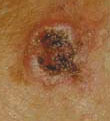
UF TEAMS WITH
PROCTOR & GAMBLE
ON SKIN CANCER TREATMENTBY JOSEPH KAYS
During his more than 20 years developing drugs for cancer, AIDS and other ailments, UF medicinal chemistry Professor Raymond Bergeron has relied on his own standard to determine the chances that a particular chemical compound will ever become a prescription drug. He calls it his “index of success.”
“At the low end of the scale would be ‘a good idea,’” Bergeron says, only half jokingly. “There are so many things that can go wrong between having a good idea and bringing a drug to the marketplace that the index of success is very low.”
So Bergeron was a little skeptical when executives of Procter & Gamble (P&G) approached him last year with a proposal to partner with the University of Florida on the development of a technology called Photoprotective Iron Chelator Technology, or PICT.Preliminary research has shown that, in combination with the appropriate sunscreen, PICT may reduce the number of individuals who develop skin cancer by greatly delaying or preventing tumor onset. It may also reduce the number of tumors in those who do develop skin cancer.
The more Bergeron talked to the P&G executives, however, the better he felt about the proposal.
“The index of success for this project was much higher than just ‘a good idea,’” says Bergeron, the Frank Duckworth Eminent Scholar in Drug Research and Development in the UF College of Pharmacy. “They already hold several patents on this compound, and they’ve done initial testing that shows it to be non-toxic for humans and effective in preventing sun damage. They basically came to UF to get it over the goal line.”
If anyone could succeed in moving PICT to the marketplace, P&G reasoned, it was Bergeron. In addition to being one of the world's leading experts on iron chelators, Bergeron heads a research team with considerable experience in producing new medicines.
“Why the University of Florida?” Jeff Weedman, P&G’s vice president of external business development and corporate licensing, asks rhetorically. “It’s quite simple — we see them as the most qualified partner. They are one of the nation’s premier research universities, and they have one of the world’s foremost experts on iron chelators in Dr. Bergeron.”
“What we bring to this is experience in drug discovery and development,” Bergeron says. “We understand how to design, assemble and evaluate therapeutic compounds.”
Bergeron adds that the University of Florida Health Science Center offers “all the expertise needed in one location. They would have had to go to numerous institutions to find a similar collection of people.”
After several months of negotiations through UF’s Office of Technology Licensing, P&G and the University of Florida Research Foundation agreed to form a new company called ChelaDerm to continue the development of the technology and seek approval for its use from the Food and Drug Administration. P&G will contribute a royalty-free, exclusive license of the PICT patents to the new company, while the research foundation will underwrite independent clinical trials and provide ChelaDerm with access to UF personnel and resources through a management services contract.
Because P&G is not able to devote resources to commercialize all of its more than 27,000 patents, the company occasionally seeks partners to advance technologies. P&G markets 250 brands to five billion consumers in 130 countries and invests nearly $2 billion a year in research and development.
Although it is not completely certain how PICT actually works, researchers have some insights, Bergeron says.
When ultraviolet light penetrates the skin it generates oxygen fragments, called free radicals, which react with iron in the skin to deteriorate it — much like water rusts metal.
These free radicals initiate a chain of events that can result in damaged skin cell membranes, production of carcinogens and breaks in DNA, leading to skin wrinkling, sunburn and cancer.
The active ingredient in PICT — 2-furildioxime or FDO — appears to protect the skin in two ways. On one hand, Bergeron says, it is an iron chelator that binds to iron in the skin, preventing its role in free radical generation. On the other hand, it is “a great free radical trap” that could neutralize the reactive oxygen fragments themselves.
“Although the precise mechanism of action clearly merits further exploration,” Bergeron says, “the task right now is to unequivocally demonstrate its efficacy in preventing sun-related skin damage.”
Because it can be applied topically and last much longer than conventional sunscreens, FDO has the potential to offer both improved prevention of sunburn and a unique means of delaying or preventing the development of skin cancer, Bergeron says.
“Consumers have become increasingly aware of the dangers of unprotected exposure to ultraviolet radiation,” says Tom Minnick, P&G’s director of external business development and president of ChelaDerm. “We’re excited to work with UF in an effort to develop a new sun care product to address both the short-term effects of sun exposure, such as sunburn, as well as the long-term effects, including skin cancer risk and premature aging of the skin.”
Initial clinical trials will confirm the safety of FDO and determine what combinations of FDO and sunscreens are most effective in preventing skin damage. The trials initially will focus on individuals with the autoimmune disease lupus, who are extremely sensitive to the sun.
“ChelaDerm offers an unprecedented opportunity for the University of Florida and P&G to pool their extensive intellectual and scientific resources in an effort to alleviate the negative impact of ultraviolet sun exposure,” says Win Phillips, UF’s vice president for research. “Facilitating the transfer of this kind of technology from the laboratory to the marketplace in a timely manner is exactly what the UF Research Foundation was established to do.”Raymond Bergeron
Eminent Scholar, Department of Medicinal Chemistry
(352) 846-1956
bergeron@mc.cop.ufl.edu
Causes
Ultraviolet (UV) radiation from the sun is the main cause of skin cancer. Artificial sources of UV radiation, such as sunlamps and tanning booths, can also cause skin cancer.Symptoms
The most common warning sign of skin cancer is a change on the skin, especially a new growth or a sore that doesn't heal. Often, the first sign of melanoma is a change in the size, shape, color, or feel of an existing mole.Treatment
Treatment for skin cancer usually involves some type of surgery. In some cases, doctors suggest radiation therapy or chemotherapy. Sometimes a combination of these methods is used. Many skin cancers can be cut from the skin quickly and easily.
Skin cancer has a better prognosis than most other types of cancer. Although skin cancer is the most common type of cancer in this country, it accounts for much less than 1 percent of all cancer deaths. It is cured in 85 to 95 percent of all cases.
Squamous cell carcinoma rarely spreads, but it does so more often than basal cell carcinoma. However, it is important that skin cancers be found and treated early because they can invade and destroy nearby tissue. Basal cell carcinoma accounts for more than 90 percent of all skin cancers in the United States. It is a slow-growing cancer that seldom spreads to other parts of the body. Melanoma is the most serious cancer of the skin. It occurs when melanocytes become malignant. Melanoma can spread to the lymph nodes and from there to other parts of the body.
Skin cancer can occur anywhere. Basal and squamous cell cancers are found mainly on areas of the skin that are exposed to the sun - the head, face, neck, hands and arms. Melanoma can occur on any skin surface. In men, it is often found on the trunk (the area from the shoulders to the hips) or the head and neck. In women, melanoma often develops on the lower legs.
Although anyone can get skin cancer, the risk is greatest for people who have fair skin that freckles easily - often those with red or blond hair and blue or light-colored eyes. You can improve your chances of finding skin cancer promptly by performing a simple skin self-exam regularly.
The best time to do this self-exam is after a shower or bath. You should check your skin in a well-lighted room using a full-length mirror and a hand-held mirror. Check all areas, including the back, the scalp and genitals. Begin by learning where your birthmarks, moles and blemishes are and what they usually look like. Check for anything new - a change in the size, texture or color of a mole, or a sore that does not heal. If you find anything unusual, see your doctor right away.For more information about skin cancer, visit the National Cancer Institute's Web site:
http://www.cancer.gov/cancer_information/cancer_type/Skin/Information provided by the National Cancer Institute



